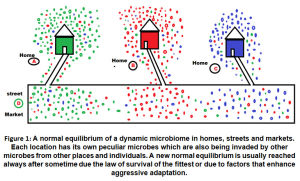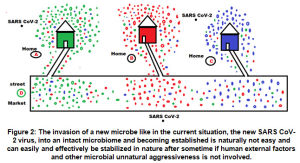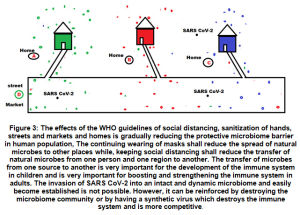South Eastern Kenya University, Department of Life Sciences. P.O. Box 170-90200, Kitui, Kenya.
Corresponding Author E-mail: jkimatu@seku.ac.ke
DOI : https://dx.doi.org/10.13005/bpj/2020
Abstract
Currently there is little universal language on how practitioners can trace and treat the progression of the COVID-19 and also much less information on its impacts on the human immune system. The emerging results from such knowledge gaps have contributed to the issuing of guidelines whose long-term effects have not been scientifically evaluated. Some of these guidelines include the WHO guidelines on SARS CoV-2 spread prevention. These guidelines mainly are wearing of masks, hand sanitization and social distancing. This paper examines some of the effects of these guidelines on the human immune system and suggestions on how to have a balance between having a strong immune system and not exposing it to pathogenic attacks when weakened. Studies have shown that microbes have a significant capacity of influencing health by being immune modulators through either their cell components or other cellular metabolites. This study proposes a microbiome targeted therapeutics strategy as a rationale for an urgent review of the WHO guidelines in order to involve the role of immune system dynamics in the fight against COVID-19 pandemic.
Keywords
Corona Virus; Microbiome; Masks; Sanitization; SARS CoV-2; Social Distance
Download this article as:| Copy the following to cite this article: Kimatu J. N. The Negative Effects of the WHO COVID-19 Prevention Guidelines on the Human Immune System. Biomed Pharmacol J 2020;13(3). |
| Copy the following to cite this URL: Kimatu J. N. The Negative Effects of the WHO COVID-19 Prevention Guidelines on the Human Immune System. Biomed Pharmacol J 2020;13(3). Available from: https://bit.ly/3duwGNs |
Introduction
SARS CoV-2 is a new corona virus which has significant contagious abilities (Li et al., 2020). However, coronaviruses are not new to the human body. The coronaviruses have been common among animals and humans for ages (Guarner, 2020). The debate of the origin of the novel SARS CoV-2 has not been concluded. We can safely say and be sure that the origin of the SARS CoV-2 is either from a natural SARS mutation or is a human synthesized virus. These are the two scientific possibilities.
The SARS CoV-2 is a new virus; therefore, the human immune system does not have its antibodies, but it can have some ideas due to its past interaction with similar corona viruses. This is what can be termed as a strategic advantage over SARS CoV-2. This strategic immunity can be related to a possible innate kind of immunity which can provide protection from coronaviruses without the need for a preconditioning of the body from the current new virus in the environment. Preliminary rational conclusion is that various people will react to SARS CoV-2 depending on how their bodies have built immune defenses against specific past exposures on corona viruses. Generally, human health is at risk but the outcome depends on individual and locational responses to corona viruses. However, this equation can be a little complicated if the SARS CoV-2 is a newly synthesized corona virus because our intervention shall be influenced by the inserted genome sequences.
Assumptions
We carefully assume that the virus is natural mutation of the SARS corona virus. However, if it is from human synthesis source, we shall try to predict the inserted sequences by the symptoms and signs it has already produced in patients or from the sequences bases available. We shall also assume that the immune system is not being influenced by other environmental factors causing similar symptoms. We have other emerging environmental factors like climate change and human factors including chemical pollutions, nano particles or electromagnetic waves including mobile phone radiations.
The immune system
In a broad sense, the immune system is a mechanism that enables living organisms to distinguish it own cells and substances (humors) from foreign ones. It has the ability to generate a specific cellular response to a new pathogen (Takeuchi and Akira, 2009). This is known as adaptive immunity. The human body has immune cells and immune organs throughout the body. Immune cells are transported throughout the body by the blood and the lymph. The Innate immune cells usually react fast and are nonspecific when foreign cells are detected but adaptive immune cells have a delay in their response but later end up forming a specific immunological memory of the intruding proteins.
Microbes are important in training and boosting the immune system
The immune system is an intricate and delicate system. Several ways have been suggested to have the capacity to boost the immune system. These include the following three ways; doing moderated exercises to increase blood circulation and hence the subsequent circulation of immune cells in the body to perform their functions, a reduction of stress to boost the endocrine system functions and also the eating of a balanced diet rich in vitamins and minerals (Scher, 2020).
Past studies have shown that diseases that plague humanity share a common ground of thriving on a dysregulated or disturbed immune system. This is because we as human beings are surrounded by huge populations of microbes (Scenario 1 below), have developed mechanisms to coexist with microbes or to keep them away (Lozupone, 2018). Microbial inhabitants are in constant interaction with the immune system on the body surface and inside our bodies. This interaction is very important in training and energizing our immune system (Olsak et al., 2012). There is evidence of microbes influencing the peripheral immune cell populations of the body thus giving a guide of how microbes consequently influence disease pathology at distal sites (Cerf-Bensussan and Gaboriau-Routhiau, 2010)
The normal body flora as a line of defense
The human body external and internal surfaces like the skin and digestive system respectively are naturally covered by a large community of microbes referred to as the normal body flora. This flora act as a physical barrier to protect the body from harmful microbes. The body flora reduces the surface for intruders and increases the competition for them to survive (Scenario 2, below). The human body also produces natural antimicrobial substances that inhibit or kill pathogens. These natural body antimicrobial substances include tears, saliva, mucus and acids. They are supposed to be maintained for the proper functioning of the body immune system. Furthermore, the body has to be stimulated to produce these useful antimicrobial substances by the same pathogens. Hence, this scenario has been in existence since time immemorial and has helped the immune system to be strong. The evolving or mutations of a new pathogen finds the same defense barrier and the body is only overcome if the defense is weakened or overcome.
WHO guidelines on the COVID-19
The world health organization (WHO) issued three major guidelines in the fight against the novel SARS CoV-2. Let us examine each one of them here and its effects on the immune system. The first is proper handwashing with the idea that the coronavirus is killed by proper handwashing for 20 seconds with soap or by using hand sanitizer that has an alcohol concentration of more than 60%.
The implications of washing hands guideline to the immune system
The human hand is one of the parts in the human body that has high community of microbes. Studies on the hand microbiome showed that there are key factors that impact the hand microbiome composition like temporal and biogeographical dynamics, intrinsic age, intrinsic gender) and extrinsic product use, extrinsic cohabitants and extrinsic pet-ownership variables. Further studies show that the hand microbiome is in constant changes as hands are a critical vector for transmitting microorganisms between people, pets, inanimate objects and our environments. (Scenario 3, below). This transmission is crucial in stimulating our immune system and preventing harmful microbes from colonizing the hands. This WHO guideline is reducing the amount of hand microbes and hence assisting in weakening the immune boosting abilities and opening the hand to new pathogens which can even include the novel SAR CoV-2. Washing with a sanitizer also makes it more difficult for the normal body flora to reoccupy their habitats due to changes of pH. The touching eyes, skin, nose and mouth and other body parts after touching other places and people boosts the strength of the immune system as a natural process by the transferring of microbes which even if they have the new SARS CoV-2 they cannot be able survive the body competitive microbiome.
Keeping a social distance
The Second WHO guidance on COVID-19 mitigation is the maintenance of a social distance or physical distance of at least 1 metre (3 feet) distance between one person and another. This was based on the idea that if someone coughs, sneezes, or speaks they are able to spray small liquid droplets from their nose or mouth which may contain the SARS CoV-2 virus and infect others. People are also advised to stay home and to self-isolate when they notice symptoms like coughing, headache and fever.
The implications of social distancing guideline to the immune system
The implication of the social distancing is that there shall be little exchange of microbes from one individual to another. This, if coupled with the washing of hands and sanitizing, shall make it very difficult to recover the normal flora populations. This shall cause a weakening of the immune system and open an opportunity for new pathogens to attack the body including the new SARS CoV-2
Wearing face masks
The third major WHO guideline on the prevention of the spread of COVID-19 is the precaution of wearing face masks in crowded places or if one would like to go out so as to avoid infecting others. This is based on the idea that infected droplets shall not be able to find their way to other people or land on surfaces to contaminate them.
The implications of wearing mask guideline to the immune system
This precaution is not natural to the body. It can increase stress in the body of people who are already bombarded with the pandemic information via media and the dare economic implications. A stressed body will have a malfunctioning endocrine system and a weaker immune system. Furthermore, the use of a mask increases the intake of carbon dioxide in the body which makes metabolism to be lower and hence negatively affect people with other under laying conditions like high blood pressure and diabetes to lack enough oxygen for proper production of energy.
 |
Figure 1: A normal equilibrium of a dynamic microbiome in homes, streets and markets. Each location has its own peculiar microbes which are also being invaded by other microbes from other places and individuals. A new normal equilibrium is usually reached always after sometime due the law of survival of the fittest or due to factors that enhance aggressive adaptation. |
 |
Figure 2: The invasion of a new microbe like in the current situation, the new SARS CoV-2 virus, into an intact microbiome and becoming established is naturally not easy and can easily and effectively be stabilized in nature after sometime if human external factors and other microbial unnatural aggressiveness is not involved. |
 |
Figure 3: The effects of the WHO guidelines of social distancing, sanitization of hands, streets and markets and homes is gradually reducing the protective microbiome barrier in human population. |
Conclusions
Natural body and environmental microbes promote the development and constant boosting of the host’s immune system. This natural occurrence has been keeping invading pathogens from destroying the immune system. Some microbes are commensals and hence they promote the development of the immune system B cells that assist the body to produce a protective antibody called Immunoglobulin A (IgA). The IgA neutralize pathogens and exotoxins and are crucial in promoting the development of the immune system. Any form of deviation from this natural mechanism can have temporal results but after sometime it shall have new waves of disease out breaks and new diseases. The natural microbiome has been known to prevent the growth of harmful pathogens by altering pH, effectively consuming nutrients required for pathogen survival, and by even secreting toxins and antibodies that inhibit growth and competition of pathogens (Lozupone, 2018)
Recommendation
The recommendation from this evaluation of the role of the microbiome is that national economies and social life should be opened and only one guideline be given to assist in fighting the SARS Cov-2. This recommendation shall nevertheless involve the educating of masses on how to cultivate the natural human microbiome defense system as a physical barrier and its role in developing and boosting the Immune system. Thusly, for the sake of the future of the health of the immune system the only recommendation proposed is that at every entry point there should be a proper checking of temperature to make sure that it is not above 37.50C. Any raised temperature to be only associated with COVID-19 if is accompanied with coughing and difficulty with breathing. The consequence is that the patient with the three symptoms (temperature, coughing and difficulty in breathing) be isolated and be treated using immune boosting protocols.
The last precaution is that, the current lockdowns are not helpful to the immune system in the long run but shall only can assist in bringing more cycles and waves of SARS Cov-2 outbreaks.
Acknowledgment
I acknowledge my family for giving me time during the COVID-19 lockdown for giving me peace to work at home.
Conflict of Interest
The author discloses that there is no conflict of interest.
Funding Source
The work is supported by South Eastern Kenya University salary support.
References
- Guarner J. Three Emerging Coronaviruses in Two Decades. Am J Clin Pathol 2020. doi: 10.1093/ajcp/aqaa029.
- Li Q, Guan X, Wu P, Wang X, Zhou L, Tong Y et al. Early transmission dynamics in Wuhan, China, of novel coronavirus-infected pneumonia. N Engl J Med. 2020.
- Takeuchi O and Akira S. Innate immunity to virus infection. Immunol Rev. 2009; 227(1):75-86.
- Scher B. Boosting your immune system to fight the coronavirus: what you need to know. Diet Doctor n.d. https://www.dietdoctor.com/coronavirus (accessed March 24, 2020)
- Kamada, N. “Control of pathogens and pathobionts by the gut microbiota”. Nature Immunology, 2013. 14 (7): 685–690. doi:10.1038/ni.2608. PMC 4083503. PMID 23778796.
- Olszak T, An D, Zeissig S, Vera MP, Richter J, Franke A, Glickman JN, Siebert R, Baron RM, Kasper DL, Blumberg RS. Microbial exposure during early life has persistent effects on natural killer T cell function. Science, 2012, 336:489 – 493.
- Lozupone CA. 2018. Unraveling interactions between the microbiome and the host immune system to decipher mechanisms of disease. mSystems 3: e00183-17.
- Cerf-Bensussan N, Gaboriau-Routhiau V. The immune system and the gut microbiota: friends or foes? Nat Rev Immunol, 2010,10:735–744.








